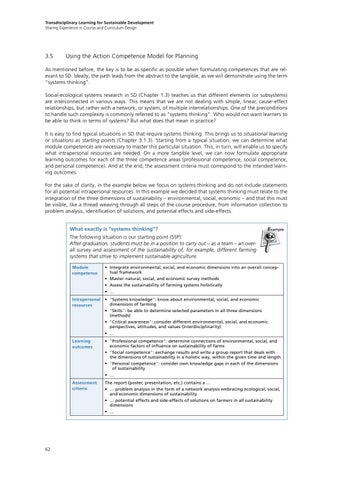Transdisciplinary Learning for Sustainable Development Sharing Experience in Course and Curriculum Design
3.5
Using the Action Competence Model for Planning
As mentioned before, the key is to be as specific as possible when formulating competences that are relevant to SD. Ideally, the path leads from the abstract to the tangible, as we will demonstrate using the term “systems thinking”. Social-ecological systems research in SD (Chapter 1.3) teaches us that different elements (or subsystems) are interconnected in various ways. This means that we are not dealing with simple, linear, cause–effect relationships, but rather with a network, or system, of multiple interrelationships. One of the preconditions to handle such complexity is commonly referred to as “systems thinking”. Who would not want learners to be able to think in terms of systems? But what does that mean in practice? It is easy to find typical situations in SD that require systems thinking. This brings us to situational learning or situations as starting points (Chapter 3.1.3). Starting from a typical situation, we can determine what module competences are necessary to master this particular situation. This, in turn, will enable us to specify what intrapersonal resources are needed. On a more tangible level, we can now formulate appropriate learning outcomes for each of the three competence areas (professional competence, social competence, and personal competence). And at the end, the assessment criteria must correspond to the intended learning outcomes. For the sake of clarity, in the example below we focus on systems thinking and do not include statements for all potential intrapersonal resources. In this example we decided that systems thinking must relate to the integration of the three dimensions of sustainability – environmental, social, economic – and that this must be visible, like a thread weaving through all steps of the course procedure, from information collection to problem analysis, identification of solutions, and potential effects and side-effects. What exactly is “systems thinking”? The following situation is our starting point (SSP): After graduation, students must be in a position to carry out – as a team – an overall survey and assessment of the sustainability of, for example, different farming systems that strive to implement sustainable agriculture. Module competence
• Integrate environmental, social, and economic dimensions into an overall conceptual framework • Master natural, social, and economic survey methods • Assess the sustainability of farming systems holistically • …
Intrapersonal resources
• “Systems knowledge”: know about environmental, social, and economic dimensions of farming • “Skills”: be able to determine selected parameters in all three dimensions (methods) • “Critical awareness”: consider different environmental, social, and economic perspectives, attitudes, and values (interdisciplinarity) • …
Learning outcomes
“Professional competence”: determine connections of environmental, social, and • economic factors of influence on sustainability of farms “Social competence”: exchange results and write a group report that deals with • the dimensions of sustainability in a holistic way, within the given time and length • “ Personal competence”: consider own knowledge gaps in each of the dimensions of sustainability • …
Assessment criteria
The report (poster, presentation, etc.) contains a … • … problem analysis in the form of a network analysis embracing ecological, social, and economic dimensions of sustainability • … potential effects and side-effects of solutions on farmers in all sustainability dimensions • …
62














